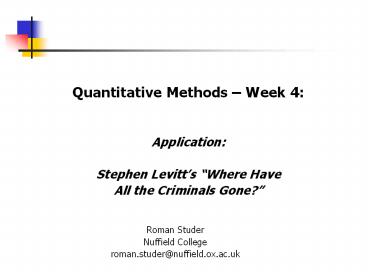Quantitative Methods PowerPoint PPT Presentation
Title: Quantitative Methods
1
- Quantitative Methods Week 4
- Application
- Stephen Levitts Where Have
- All the Criminals Gone?
Roman Studer Nuffield College roman.studer_at_nuffiel
d.ox.ac.uk
2
Where Have All the Criminals Gone?
- List all the variables that Lewitt looks at in
the course of the chapter
- unemployment rate.
- number of criminals sent to prison.
- length of prison sentences.
- number of executions.
- number of police officers.
- number of guns.
- price of cocaine.
- innovation in police techniques (dummy variable).
- number of conceptions.
- number of births.
- number of abortions.
- number of children living in poverty.
- number of single parents.
- average age of total population
- number of crimes.
- state.
- year.
- number of violent crimes.
- number of financially motivated crimes.
- number of homicides.
- number of homicides involving a gun.
- number of drug related homicides.
- economic growth.
- gender of criminals
- ethnicity of criminals.
- age of criminals.
? What are the level of measurements, what are
the basic units of observations (cases)? Are all
ratio measurements?
3
Where Have All the Criminals Gone?
- Many factors (variables) are potentially
associated with the drop in crime rates in the
US. Where does he find correlations between a
variable and the falling crime rate? Which
variables are positively, which ones negatively
correlated with the crime rate variable? Where
does he find no correlation?
Concept/Variable
Measured Variable
Correlation
No correlation
Strong economy
Unemployment rate, growth rate
Negative 33
Reliance on prisons
Number of prisoners
Capital punishment
Number of executions
No correlation
Negative (but) 10
Number of police
Number of policemen
No correlation
Innovative policing strategies
..
4
Where Have All the Criminals Gone?
Concept/Variable
Measured Variable
Correlation
Tougher gun laws
Brady act,
No correlation (in the present context)
Negative 15
Changes in crack market
Price of crack
Aging of population
??
No correlation
Legalizing abortion
Number of abortions
Negative The rest? About 50
5
Where Have All the Criminals Gone?
- In which cases does Lewitt move from correlation
to causation? How does he justify this change in
language? Is it convincing? - Does this chapter potentially suffer from a
omitted variable problem? Of what other factors
can you think for explaining the fall in crime
rates? - For each potential factor, he provides both the
relevant data and some common sense explanation.
What do you believe more the data or the
explanations? Why does he need the explanations
at all? - Are you convinced by Lewitts overall argument?
Has the fall in crime rate in the US herewith
been explained once and for all?
6
Where Have All the Criminals Gone?
Source Bureau of Justice Statistics,
http//www.ojp.usdoj.gov/bjs/glance.htmCrime
7
Again Caution when Interpreting Correlation
Results!!
- Correlation is NOT causation!!
- Causation is very hard to ascertain in social
sciences - Beware of spurious or nonsense correlation!
- Examples
- Simultaneous decline of birth rates and of the
number of storks in Sweden - Positive correlation between shoe size and income
level - Omitted variables are one of the big problems in
econometrics
8
Caution when Interpreting Correlation Results (II)
- Watch out for the influence of outliers on the
correlation results!! - Example GDP per person and purchasing power
around the world, 2007
- Very strong association
- Positive correlation
- r 0.95
- Just 2 outliers
- Weak association suggested
- r 0.34
9
Computer Class
- Replicating Levitts Results with US
Macroeconomic Data
10
US Macro Dataset
- We will no try to replicate some of Levitts
results using national statistics from the US - Sources U.S. Department of Justice, Bureau of
Justice Statistics US Census Bureau - Variables Crime (total and rates), number of
prisoners, abortion rate, education,
unemployment, poverty - Get dataset at http//www.nuff.ox.ac.uk/users/stud
er/teaching.htm
11
Exercises
- Data set and descriptive statistics
- Open dataset and convert the Excel dataset into a
Stata dataset - Look at each of the variables in turn
- Produce appropriate graphs Get a first
visualisation of the data does it look normally
distributed? - Produce nice graphs including titles, etc.
- Compute the mean, median, standard deviation,
coefficient of variation, kurtosis and skewness
for every variable - How do the different crime variables compare?
Which one do you take for the correlation
analysis? - Correlation analysis
- Look at the association between crime and the
other variables - Make a scatter plot to get a first impression of
their association Do you think these variables
are connected? Positively/negatively? - Calculate the correlation coefficient how would
you explain the result? - If you look at the scatter plot, are there any
outliers?
12
Exercises (II)
- Save your data set and your results on the O
drive - Save your new data set as a Stata file (.dta)
- Export and save your data set as an Excel file
(.xls) - Copy your results and save them in a word file
(.doc)
13
Appendix STATA Commands
- correlate varlist Displays all the pairwise
Pearson correlation - coefficients between the variables listed
after - correlate
- pwcorr varlist Like correlate, but has some
additional options like calculating the
significance level - spearman varlist Displays Spearman's rank
correlation coefficients for all pairs of
variables - scatter varname1 varname2 Produces a scatter
plot with variable 1 on the x-axis and variable
2 on the y-axis
14
Homework
- Readings
- Feinstein Thomas, Ch. 4
- Problem Set 3
- Finish the exercises from todays computer class
if you havent done so already. Include all the
results and answers in the file you send me - Do exercise 3 from Feinstein Thomas, p. 91
(using Relief dataset)

